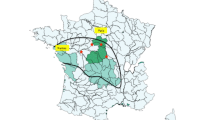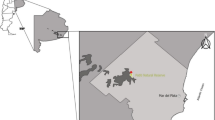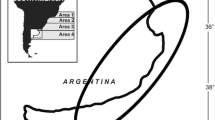Abstract
Peregrine falcons were extirpated from the eastern United States by 1964 due to the effects of dichloro-diphenyl-trichlorethane (DDT) (Peakall and Kiff 1988). As a result of restoration efforts, peregrines have largely recovered in the region but remain a barometer of environmental contamination. In the course of monitoring nests, biologists in the mid-Atlantic states collected peregrine falcon eggs that failed to hatch. In the period 1993–1999, 93 eggs were collected from 66 nests in 31 locations in New Jersey, Pennsylvania, Delaware, Maryland, and Virginia. We analyzed eggs for organochlorine pesticides, PCBs, and metals, and calculated toxic equivalencies (TEQs) for dioxins and furans. Organochlorine contaminants were detected in eggs from all parts of the region. Although nest success in all parts of the region was good, the PCB TEQ in the Atlantic–New Jersey region was significantly related to nest success, and the regionwide PCB TEQ was nearly significant for nest success across the five-state area. dichloro-diphenyl-dichloroethylene (DDE), DDT, and total PCBs were negatively correlated with eggshell thickness, although eggshell thinning (10.4%) was not at a level associated with deleterious population effects. The five states represented in this study are productive for peregrine falcons and have contributed to the recovery of this species. However, the results suggest that Atlantic coastal peregrines might be subject to contaminant burdens that have the potential to decrease nest success and productivity.



Similar content being viewed by others
References
Anderson DW, Hickey JJ (1972) Eggshell changes in certain North American birds. Proc Int Ornithol Congr 15:514–540
Augspurger T, Boynton A (1998) Organochlorines and mercury in peregrine falcon eggs from western North Carolina. J Raptor Res 32:251–254
Berger DD, Sindelar CE Jr, Gamble KE (1969) The status of breeding peregrines of the eastern United States. In: Hickey JJ (ed) Peregrine falcon populations: their biology and decline. University of Wisconsin Press, Madison, pp 165–173
Brooks JM, Wade TL, Atlas EL, et al (1989) Analysis of bivalves and sediments for organic chemicals and trace elements. Third Annual Report for NOAA’s National Status and Trends Program, Contract 50 DGNC–5-00262
Bunn TL, Marsh JA, Dietert RR (2000) Gender differences in developmental immunotoxicity to lead in the chicken: analysis following a single early low-level exposure in ovo. J Toxicol Environ Health 61A:677–693. doi:10.1080/00984100050195152
Burns SA, Jarman WM, Cade TJ, Kiff LF, Walton BJ (1994) Organochlorines and eggshell thinning in peregrine falcon (Falco peregrinus) eggs from the eastern United States 1986–88. In: Meyburg BU, Chancellor RD (eds) Raptor conservation today. The Pica Press, London, pp 709–716
Cade TJ (2003) Starting the peregrine fund at Cornell University and eastern reintroduction. In: Cade TJ, Burnham W (eds) Return of the peregrine: a North American saga of tenacity and teamwork. The Peregrine Fund, Boise, ID, pp 73–103
Clark KE, Stansley W, Niles LJ (2001) Changes in Contaminant levels in New Jersey osprey eggs and prey, 1989 to 1998. Arch Environ Contam Toxicol 40:277–284
Court GS, Gates CC, Boag DA et al (1990) A toxicological assessment of peregrine falcons, Falco peregrinus tundrius, breeding in the Keewatin District of the Northwest Territories, Canada. Can Field-Naturalist 104:255–272
Delaware River Basin Commission (1998) Study of the loadings of polychlorinated biphenyls from tributaries and point sources discharging to the tidal Delaware River. Delaware River Basin Commission, West Trenton, NJ
Edens FW, Garlich JD (1983) Lead-induced egg production decrease in Leghorn and Japanese quail hens. Poult Sci 62:1757–1763
Eisler R (1987) Mercury hazards to fish, wildlife, and invertebrates: a synoptic review. US Fish and Wildlife Service Biology Report 85(1.10)
Hartley RR, Newton I, Robertson M (1995) Organochlorine residues and eggshell thinning in the Peregrine Falcon Falco peregrinus minor in Zimbabwe. Ostrich 66:69–73
Heinz GH (1996) Selenium in birds. In: Beyer WN, Heinz GH, Redmon-Norwood AW (eds) Environmental contaminants in wildlife: interpreting tissue concentrations. CRC Press, Boca Raton, FL, pp 447–458
Heinz GH, Hoffman DJ (2003) Embryotoxic thresholds of mercury: estimates from individual mallard eggs. Arch Environ Contam Toxicol 44:257–264. doi:10.1007/s00244-002-2021-6
Henny CJ, Ganusevich SA, Ward FP, Schwartz TR (1994) Organochlorine pesticides, chlorinated dioxins and furans, and PCBs in Peregrine falcon Falco peregrinus eggs from the Kola Peninsula, Russia. In: Meyburg BU, Chancellor RD (eds) Raptor conservation today. The Pica Press, London, pp 739–749
Herzke D, Kallenborn R, Nygard T (2002) Organochlorines in egg samples from Norwegian birds of prey: congener-, isomer- and enantiomer specific considerations. Sci Total Environ 291:59–71. doi:10.1016/S0048-9697(01)01092-0
Hoffman DJ, Heinz GH (1988) Embryotoxic and teratogenic effects of selenium in the diet of mallards fed selenium. J Toxicol Environ Health 24:477–490
Jarman WM, Burns SA, Bacon CE et al (1996) High levels of HCB and DDE associated with reproductive failure in prairie falcons (Falco mexicanus) from California. Bull Environ Contam Toxicol 57:8–15
Jarman WM, Burns SA, Chang RR et al (1993) Determination of PCDDs, PCDFs and PCBs in California peregrine falcons Falco Peregrinus and their eggs. Environ Toxicol Chem 12:105–114. doi:10.1897/1552-8618(1993)12[105:DOPPAP]2.0.CO;2
Lambertsson L, Nilsson M (2006) Organic material: the primary control on mercury methylation and ambient mercury concentrations in estuarine sediments. Environ Sci Technol 40:1822–1829. doi:10.1021/es051785h
Lindberg P, Odsjo T, Reutergardh L (1985) Residue levels of polychlorobiphenyls, SumDDT, and mercury in bird species commonly preyed upon by the peregrine falcon (Falco peregrinus Tunst.) in Swden. Arch Environ Contam Toxicol 14:203–212. doi:10.1007/BF01055613
Lundholm CE (1997) DDE-induced eggshell thinning in birds: effects of p, p’-DDE on the calcium and prostaglandin metabolism of the eggshell gland. Comp Biochem Physiol 118C:113–128
MacLeod WD, Brown DW, Friedman AJ et al (1985) Standard analytical procedures of the NOAA national analytical facility 1985–1986. Extractable toxic organic compounds, 2nd edn. US Department of Commerce, NOAA/NMFS, NOAA Tech. Memo. NMFS F/NWRC-92. US Government Printing Office, Washington, DC
Malisch R, Baum F (2007) PCDD/Fs, Dioxin-like PCBs and marker PCBs in eggs of peregrine falcons from Germany. Chemosphere 67:S1–S15. doi:10.1016/j.chemosphere.2006.05.149
Merino R, Bordajandi LR, Abad E, Rivera J, Jiménez B (2005) Evaluation of organochlorine compounds in peregrine falcon (Falco peregrinus) and their main prey (Columba livia) inhabiting Central Spain. Environ Toxicol Chem 24:192–197. doi:10.1897/04-018R.1
NJ Department of Environmental Protection Water Monitoring and Standards (2006) New Jersey integrated water quality monitoring and assessment report, Trenton, NJ
Newton I (1988) Determination of critical pollutant levels in wild populations, with examples from organochlorine insecticides in birds of prey. Environ Pollut 55:29–40. doi:10.1016/0269-7491(88)90157-1
Newton I, Bogan JA, Haas MB (1989) Organochlorines and mercury in the eggs of British Peregrines Falco peregrinus. Ibis 131:355–376. doi:10.1111/j.1474-919X.1989.tb02785.x
Nyholm NEI (1998) Influence of heavy-metal exposure during different phases of the ontogeny on the development of pied flycatchers, Ficedula hypoleuca, in natural populations. Environ Contam Toxicol 35:632–637. doi:10.1007/s002449900425
Peakall DB, Kiff LF (1988) DDE contamination in peregrines and America kestrels and its effect on reproduction. In: Cade TJ, Enderson JH, Thelander CG, White CM (eds) Peregrine falcon populations: their management and recovery. The Peregrine Fund, Inc., Boise, ID, pp 337–350
Peakall DB, Noble DG, Elliott JE, Somers JD, Erickson G (1990) Environmental contaminants in Canadian peregrine falcons, Falco peregrinus: a toxicological assessment. Can Field Nat 104:244–254
Poland A, Knutson JC (1982) 2, 3, 7, 8-Tetrachlorodibenzo-p-dioxin and related halogenated aromatic hydrocarbons: examination of the mechanism of toxicity. Annu Rev Pharmacol Toxicol 22:517–554. doi:10.1146/annurev.pa.22.040182.002505
Porcella DB, Huckabee JW, Wheatley B (eds) (1995) Mercury as a Global Pollutant. Water Air Soil Pollut 80:1–4
Rattner BA, McGowan PC, Golden NH et al (2004) Contaminant exposure and reproductive success of ospreys (Pandion haliaetus) nesting in Chesapeake Bay regions of concern. Arch Environ Contam Toxicol 47:126–140. doi:10.1007/s00244-003-3160-0
Rice CP, O’Keefe PW (1995) Sources, pathways and effects of PCBs, dioxins, and dibenzonfurans. In: Hoffman DJ, Rattner BA, Burton GA Jr, Cairns J Jr (eds) Handbook of ecotoxicology. Lewis, Boca Raton, FL, pp 424–468
Safe S, Robertson LW, Safe L et al (1982) Halogenated biphenyls: molecular toxicology. Can J Physiol Pharmacol 60:1057–1064
SAS Institute Inc. (1999) SAS/STAT@ user’s guide. Version 8, Vol 2. SAS Institute Inc., Cary, NC
Steidl RJ, Griffin CR, Niles LJ, Clark KE (1991) Reproductive success and eggshell thinning of a reestablished peregrine falcon population. J Wildl Manage 55:294–299. doi:10.2307/3809153
Steidl RJ, Griffin CR, Augspurger TP, Sparks DW, Niles LJ (1997) Prey of peregrine falcons from the New Jersey coast and associated contaminant levels. North Wildl 52:11–19
Stickel LF, Wiemeyer SN, Blus LJ (1973) Pesticide residues in eggs of wild birds: adjustment for loss of moisture and lipid. Bull Environ Contam Toxicol 9:193–196. doi:10.1007/BF01684824
Taylor BJ, Presley BJ (1998) TERL: trace element quantification technique. NOAA Technical Memorandum NOS ORCA 130, Sampling and Analytical Methods of the National Status and Trends Program—Mussel Watch Project 1993–1996 Update, Silver Springs MD, p 43
Thompson DR (1996) Mercury in birds and terrestrial mammals. In: Beyer WN, Heinz GH, Redmon-Norwood AW (eds) Environmental contaminants in wildlife: interpreting tissue concentrations. CRC Press, Boca Raton, FL, pp 341–356
Tondeur Y (1987) (Revision 0, November 1990) Method 8290: analytical procedures and quality assurance for multimedia analysis of polychlorinated dibenzo-p-dioxins and dibenzofurans by high-resolution gas chromatography/high-resolution mass spectrometry. USEPA, EMSL, Las Vegas, NV
Toschik PC, Rattner BA, McGowan PC et al (2005) Effects of contaminant exposure on reproductive success of ospreys (Pandion haliaetus) nesting in Delaware River and Bay, USA. Environ Toxicol Chem 24:617–628. doi:10.1897/04-141R.1
US EPA (US Environmental Protection Agency) (1990) Revision A. Method 1613: tetra- through octa-chlorinated dioxins and furans by isotope dilution HRGC/HRMS. US EPA, Office of Water Regulation and Standards, Industrial Technology Division, Washington, DC
US EPA (US Environmental Protection Agency) (2003) Analysis of laboratory and field studies of reproductive toxicity in birds exposed to dioxin-like compounds for use in ecological risk assessment. USEPA, NCEA, Research and Development, Cincinnati, OH
US Federal Register (1999). 50 CFR Part 17, Endangered and threatened wildlife and Plants; final rule to remove the American peregrine falcon from the federal List of Endangered and Threatened Wildlife. Vol. 64:164, August 25, 1999
USFWS (US Fish and Wildlife Service) (1994) Contaminants in peregrine falcon (Falco peregrinus) eggs from Virginia, Maryland, and West Virginia. Technical report of the USFWS, Virginia Field Office, Gloucester, VA, p 19
US Fish and Wildlife Service and New Jersey Division of Fish, Game and Wildlife (1998) Reproductive success and egg contaminant concentrations of southern New Jersey peregrine falcons. USFWS, New Jersey Field Office, Pleasantville, NJ, p 45
Van den Berg M, Brinbaum L, Bosveld ATC et al (1998) Toxic equivalency factors (TEFs) for PCBs, PCDDs, PCDFs for humans and wildlife. Environ Health Perspect 106:775–792. doi:10.2307/3434121
Wade TL, Atlas EL, Brooks JM et al (1988) NOAA Gulf of Mexico status and trends program: trace organic contaminant distribution in sediments and oyster. Estuar 11:171–179. doi:10.2307/1351969
White DM, Clum NJ, Cade TJ, Hunt WG (2002) Peregrine falcon (Falco peregrinus) In: Poole A, Gill F (eds) The birds of North America, No. 660. The Birds of North America, Inc., Philadelphia
Wiemeyer SN, Porter RD, Hensler GL, Maestrelli JR (1986) DDE, DDT + dieldrin: residues in American kestrels and relations to reproduction. US Department of the Interior, Fish and Wildlife Service, Fish and Wildlife Technical Report 6. Washington, DC, p 33
Wiemeyer SN (1996) Other organochlorine pesticides in birds. In: Beyer WN, Heinz GH, Redmon-Norwood AW (eds) Environmental contaminants in wildlife: interpreting tissue concentrations. CRC Press, Boca Raton, FL, pp 99–116
Wolfe MF, Schwarzbach S, Sulaiman RA (1998) Effects of mercury on wildlife: a comprehensive review. Environ Toxicol Chem 17:146–148. doi: 10.1897/1551-5028(1998)017<0146:EOMOWA>2.3.CO;2
Acknowledgments
We wish to thank those who field-checked peregrine falcon nests and collected eggs in the five states that participated in this study, including coordinating biologists: D. Brauning, C. Heckscher, C. Koppie, and B. Watts. We also thank Dr. M C. Newman who provided guidance on statistical analysis. This study was funded by the US Fish and Wildlife Service with contributions from the states. We appreciate the improvements suggested by two anonymous reviewers.
Author information
Authors and Affiliations
Corresponding author
Rights and permissions
About this article
Cite this article
Clark, K.E., Zhao, Y. & Kane, C.M. Organochlorine Pesticides, PCBs, Dioxins, and Metals in Postterm Peregrine Falcon (Falco peregrinus) Eggs from the Mid-Atlantic States, 1993–1999. Arch Environ Contam Toxicol 57, 174–184 (2009). https://doi.org/10.1007/s00244-008-9248-9
Received:
Accepted:
Published:
Issue Date:
DOI: https://doi.org/10.1007/s00244-008-9248-9




